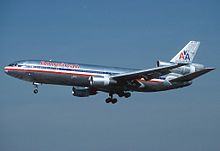American Airlines Flight 96

An American Airlines DC-10 identical to the one involved in the incident.
|
|
| Incident summary | |
|---|---|
| Date | June 12, 1972 |
| Summary | Cargo door failure due to design flaw leading to explosive decompression |
| Site | Detroit Metropolitan Wayne County Airport |
| Passengers | 56 |
| Crew | 11 |
| Fatalities | 0 |
| Injuries (non-fatal) | 11 (2 crew, 9 passengers) |
| Survivors | 67 (all) |
| Aircraft type | McDonnell Douglas DC-10-10 |
| Operator | American Airlines |
| Registration | N103AA |
| Flight origin | Los Angeles Int'l Airport |
| Stopover | Detroit Metropolitan Wayne County Airport |
| Last stopover | Buffalo Niagara International Airport |
| Destination | LaGuardia Airport |
American Airlines Flight 96 was a regular McDonnell Douglas DC-10-10 flight operated by American Airlines. On June 12, 1972, the aircraft's rear cargo door blew off while flying over Windsor, Ontario, en route from Detroit Metropolitan Wayne County Airport to Buffalo Niagara International Airport; it is thus sometimes referred to as the Windsor incident.
The rapid decompression in the cargo hold caused a partial collapse of the passenger compartment floor, which in turn jammed or restricted some of the control cables which led to various flight control hydraulic actuators. The jamming of the rudder control cable caused the rudder to deflect to its maximum right position. The cable controls to the number two (tail) engine were severed, causing that engine to shut down. Fortunately, there was no rupture of any hydraulic system, so the pilots still had control of the ailerons, the right elevator and the horizontal stabilizer. However, because the right elevator cable was partially restricted, both pilots had to apply back pressure on the yoke for the landing flare. Additionally, the approach and landing had to be made at high speed, to prevent the sink rate from becoming too high. The tendency to turn right was offset by using 45 degrees of left aileron, combined with asymmetrical thrust of the two wing engines. In spite of the partial restriction of the controls, the pilots were able to return to Detroit Metropolitan Wayne County Airport and land safely with no major injuries.
The cause was later traced to the door latching system, which had failed to close completely. A separate locking system was supposed to ensure this could not happen, but proved to be inadequate. McDonnell Douglas instituted a number of minor changes to the system in an attempt to avoid a repeat, but two years later, on March 3, 1974, Turkish Airlines Flight 981's rear cargo door blew off for exactly the same reason, causing the aircraft to lose all control and crash into a forest outside Paris, killing all 346 people on board, at the time, it was the deadliest plane crash in aviation history until the Tenerife disaster, and was deadliest single aircraft crash until Japan Airlines Flight 123.
...
Wikipedia
